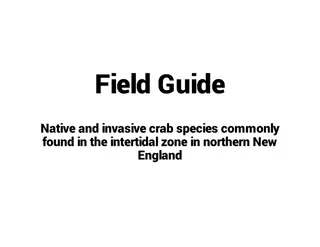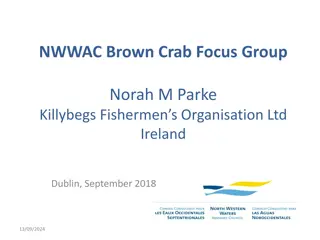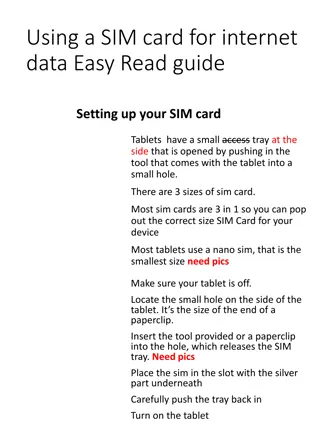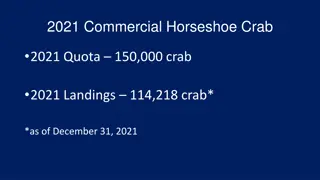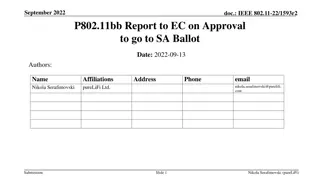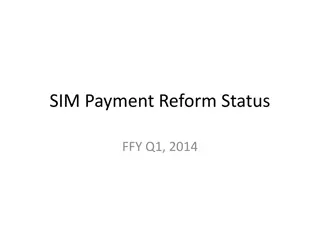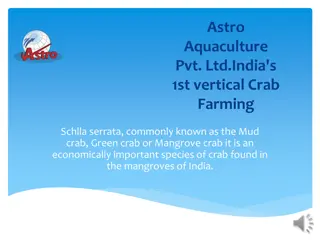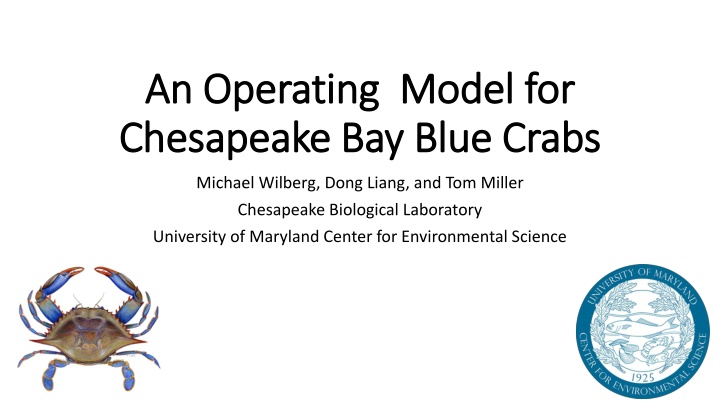
Operating Model for Chesapeake Bay Blue Crabs Analysis
The operating model for Chesapeake Bay blue crabs presented by Wilberg, Liang, and Miller utilizes length-structured data generating models for stock assessment. This approach allows for a more detailed description of population dynamics, particularly valuable for crustaceans like blue crabs. The model incorporates growth, maturation, fishing mortality, natural mortality, and recruitment processes to simulate population dynamics. Multiple surveys and fisheries data inform the model, enhancing its accuracy and utility in management decisions.
Download Presentation

Please find below an Image/Link to download the presentation.
The content on the website is provided AS IS for your information and personal use only. It may not be sold, licensed, or shared on other websites without obtaining consent from the author. If you encounter any issues during the download, it is possible that the publisher has removed the file from their server.
You are allowed to download the files provided on this website for personal or commercial use, subject to the condition that they are used lawfully. All files are the property of their respective owners.
The content on the website is provided AS IS for your information and personal use only. It may not be sold, licensed, or shared on other websites without obtaining consent from the author.
E N D
Presentation Transcript
An Operating Model for An Operating Model for Chesapeake Bay Blue Crabs Chesapeake Bay Blue Crabs Michael Wilberg, Dong Liang, and Tom Miller Chesapeake Biological Laboratory University of Maryland Center for Environmental Science
Framework Length-structured data generating model (operating model) Stock assessment model (estimation model) Observation Estimation Operating Model Simulated data Assessment model process process ? = Known values Estimated values
Operating model: length-structured models Many organisms are difficult to age crustaceans, molluscs Size- or stage-based models have been developed Including the most recent assessment model for blue crab Stage-based models provide only a coarse description of the population (2- 3 stages), and typically operate on annual time steps, which does not reflect the management tools used (small changes in minimum size and seasonal closures) Length-structured models can track changes in small size classes (~5 mm), and at shorter time scales (months) to provide more resolved descriptions of the population dynamics. These models can also be used to simulate population dynamics and data sets serving as an operating model Length-structured stock assessment approaches have been developed (Sullivan et al. 1990; Punt 2013; Cao et al. 2017)
Multiple survey and fisheries data to inform the operation model. Maryland Department of Natural Resources Blue Crab Winter Dredge Survey Blue Crab Summer Trawl Survey Blue Crab Harvest Reports Virginia Institute of Marine Science Blue Crab Winter Dredge Survey Juvenile Fish and Blue Crab Trawl Survey Chesapeake Bay Multispecies Monitoring and Assessment Program Virginia Marine Resources Commission Blue Crab Harvest Reports Potomac River Fisheries Commission Blue Crab Harvest Reports
Operating model processes Growth Maturation (for females) Fishing mortality Natural mortality Recruitment
Operating model - Growth Growth follows a stochastic increment von Bertalannfy growth model K is proportional to the cumulative growing degree days (GDD) during a month (Km = kp GDDm) L constant over time and same for both sexes Normally distributed growth increment with a variance calculated using variance of L , K and their correlation (formulation from Cao et al. 2017) Females stop growing when they mature
Operating model- Growing degree days Temperature using a sin function with AR(1) errors
Operating model Mean growth Stochastic von Bertalanffy growth model Normally distributed growth increment with a variance calculated using variance of L , K and their correlation (formulation from Cao et al. 2017)
Operating model Female maturity Female maturity follows a logistic function (Bunnell & Miller 2006)
Operating model - Recruitment and Selectivity Recruitment in months 5-10 (0 in other months) Lognormal recruitment each month with a median = 2000 and SD = 0.45 Currently no stock- recruitment function Logistic fishery and survey selectivity
Operating model - Mortality Natural mortality (0.075/mo) and fishing mortality (0.0875/mo)
Population over time (males)
Population over time (immature females)
Population over time (mature females)
Observation process Observation error was applied to the catch and index for each month and the catch and index proportions at length each month Fishery catch- length composition Lognormal catch errors: CV = 10% Surveys length composition Lognormal index errors: CV = 30% Multinomial proportions at length: effective sample size = 250 Simulated 20 data sets for 3 years with 10 months/year (30 time steps)
Simulation survey observations
Catch over time (males)
Conclusions and next steps When the estimation model is correctly specified, the estimates are approximately unbiased, which is promising for the upcoming assessment A population simulation model will be built based on the available data to ensure reasonable out-of-sample indices of abundance with reasonable prediction and accuracy. Further development of the operating model Add spatial structure for blue crabs Add stock-recruitment function (and juvenile density dependent mortality?) Additional stochastic variation in growth and natural mortality Conduct experiments with the operation model to test the current stock assessment model performance.
Acknowledgments Funding Chesapeake Bay Trust Collaborators Blue crab simulation model steering committee




